Location: Ha Long Bay & Cat Ba Island
Quang Ninh Province, Northern Vietnam
At the end of every year, my workplace receives a giant 1-year calendar from a local company, featuring a stunning landmark from somewhere in the world. I always look forward to that photo, ready to indulge in some serious wanderlust. A few years ago, the photo was of a place called Ha Long Bay, which I discovered, much to my surprise, was located in Northern Vietnam. I decided right then and there, that if I ever made it to Southeast Asia, I would visit this picturesque area. Fast forward several years, and I found myself on top of a boat, basking in the sun, sailing my way through the wonder that is Ha Long Bay.
 Taken at the top of Ti Top Island, the ‘calendar photo’ was similar to this one; the photo that inspired an adventure!
Taken at the top of Ti Top Island, the ‘calendar photo’ was similar to this one; the photo that inspired an adventure!
Ha Long Bay is located approximately 150 km east of Hanoi, in the South China Sea. This UNESCO World Heritage site welcomes over 700 cruise boats every single day. Every. Single. Day. Incredible! With so many tour companies operating boats in the region, it’s a challenge to even pick one! How do you decide? Luckily, we live in the age of the internet & Tripadvisor reviews came to the rescue! Most visitors acknowledge that while Ha Long Bay is beautiful and impressive, it is becoming overcrowding and suggest Cat Ba Bay as an alternative.
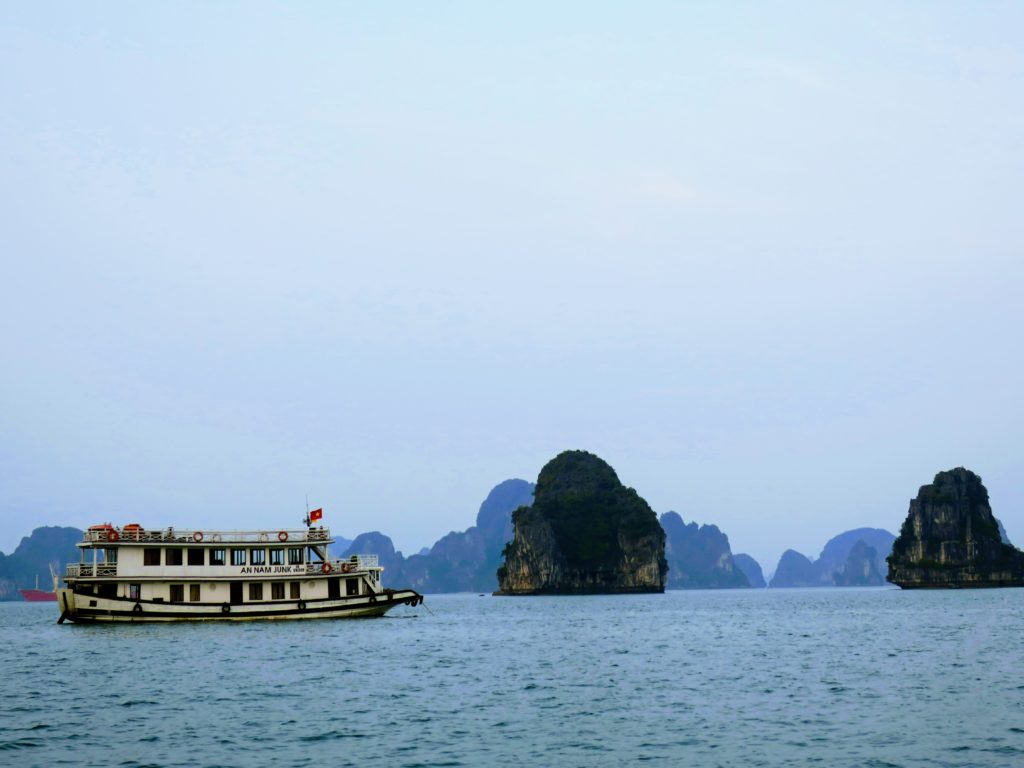 That’s how I finally settle on a 2 night / 3 day cruise that covered both sites. Now, those who know me well know that I don’t always read the fine print in things. I knew that most companies offered excursions such as kayaking and cycling, so once I confirmed that my specific tour offered those (and that I could opt out and stay behind to lounge on the boat if I wanted), I skimmed over the brochure and handed over my money. And, like everything in Vietnam, you have different price options, depending on your needs. I opted for the middle range, which promised to include amongst other things ‘good food’ (as opposed to ‘bad’ food?) and a guide who spoke English.
That’s how I finally settle on a 2 night / 3 day cruise that covered both sites. Now, those who know me well know that I don’t always read the fine print in things. I knew that most companies offered excursions such as kayaking and cycling, so once I confirmed that my specific tour offered those (and that I could opt out and stay behind to lounge on the boat if I wanted), I skimmed over the brochure and handed over my money. And, like everything in Vietnam, you have different price options, depending on your needs. I opted for the middle range, which promised to include amongst other things ‘good food’ (as opposed to ‘bad’ food?) and a guide who spoke English.

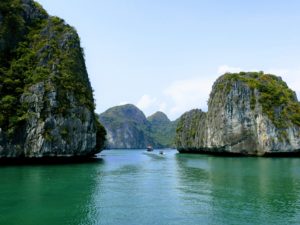 As soon as we set sail, it became crystal clear why this area was so popular! The bay is home to approximately 2000 limestone islets, varying in size and configuration. Carved out over 500 million years, it’s no wonder that this area is a favourite in Hollywood: Kong’s Skull Island is located (and was filmed) right here!
As soon as we set sail, it became crystal clear why this area was so popular! The bay is home to approximately 2000 limestone islets, varying in size and configuration. Carved out over 500 million years, it’s no wonder that this area is a favourite in Hollywood: Kong’s Skull Island is located (and was filmed) right here!
According to our guide (and Wikipedia!), ‘Historical research surveys have shown the presence of prehistoric human beings in this area tens of thousands years ago.’ There are many caves on the islets, wear early sea-faring Vietnamese made their homes. The larger, more popular ones draw crowds of excited tourists every day (more on that later)

After a hearty lunch on the boat, our group set out for our first adventure: kayaking! There were 15 of us, plus our local guide. We tandem kayaked on the sea to a nearby beach, where swimming was allowed. However, I had been told by a fellow traveller I met a few days back, that when she did the cruise, they were told not to swim in the water for health reasons. One quick look at all the trash floating in the water on the beach was enough to convince me to take her advice. I wouldn’t say necessarily that the water was contaminated or anything, simply that there was visible trash floating all around. Regardless, the view were spectacular! We then kayaked to another small island were we hiked to explore a nearby cave. Now, for anyone who’s kayaked in an open style craft before, you know that you end up wet from the waist down. Pair that with wet flip-flops + bouldering / climbing sharp rocks and that equals a recipe for disaster! Luckily, after ditching my treacherous footwear and continuing barefoot, my shipmates and I escaped with only a few minor cuts, scrapes and bruises!
After 2.5 hrs of sea kayaking, it was back to the boat for 2-1 happy hour, a cooking lesson (wet spring rolls), an intricately presented dinner and finally bedtime! This was the first time I had ever slept on a boat while at sea! Luckily, we were anchored in a secluded cove, far away from the 699 other ships preparing to do the same. I slept soundly that night, lulled to sleep by the gentle rocking of the waves.
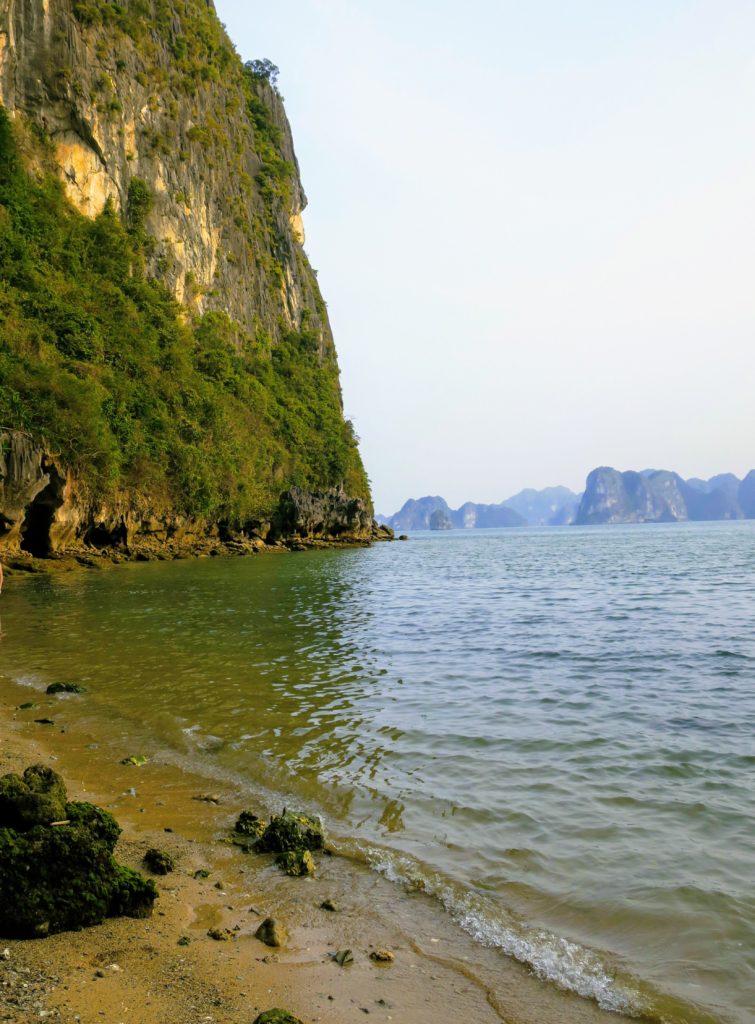
 Photo, left: the ‘beach’ where we could swim… a long way from the white-sand, crystal clear water beaches of Hawaii! Photo, right: Interesting stalactite & stalagmite formations in the cave.
Photo, left: the ‘beach’ where we could swim… a long way from the white-sand, crystal clear water beaches of Hawaii! Photo, right: Interesting stalactite & stalagmite formations in the cave.
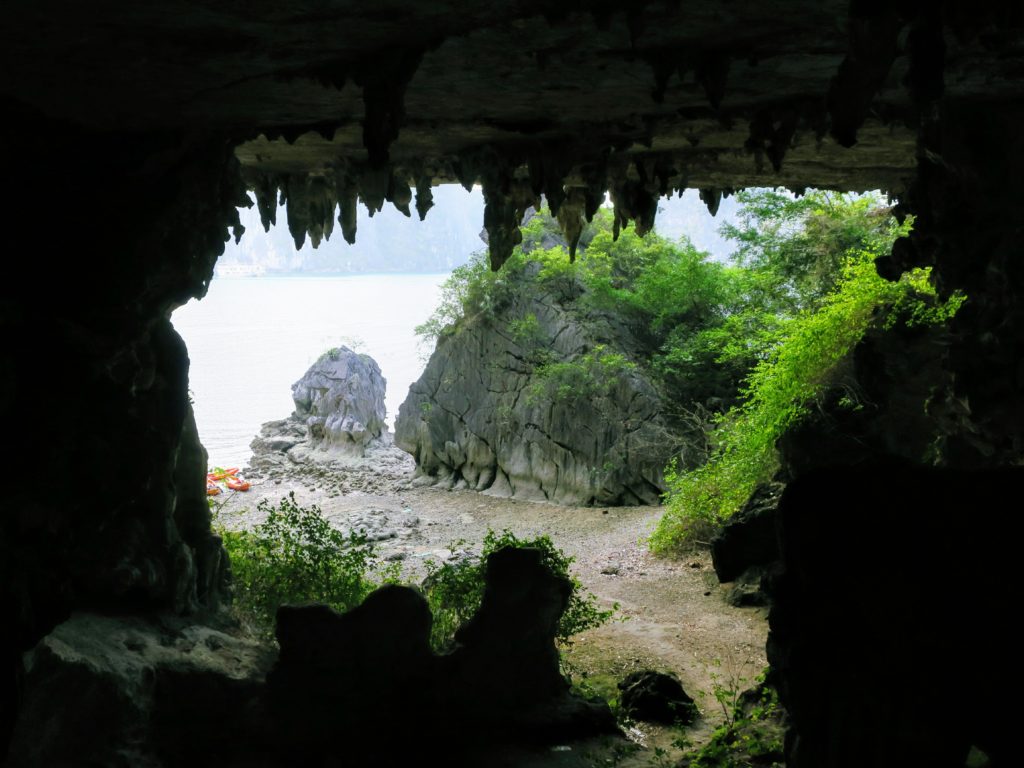 Cave with a view
Cave with a view
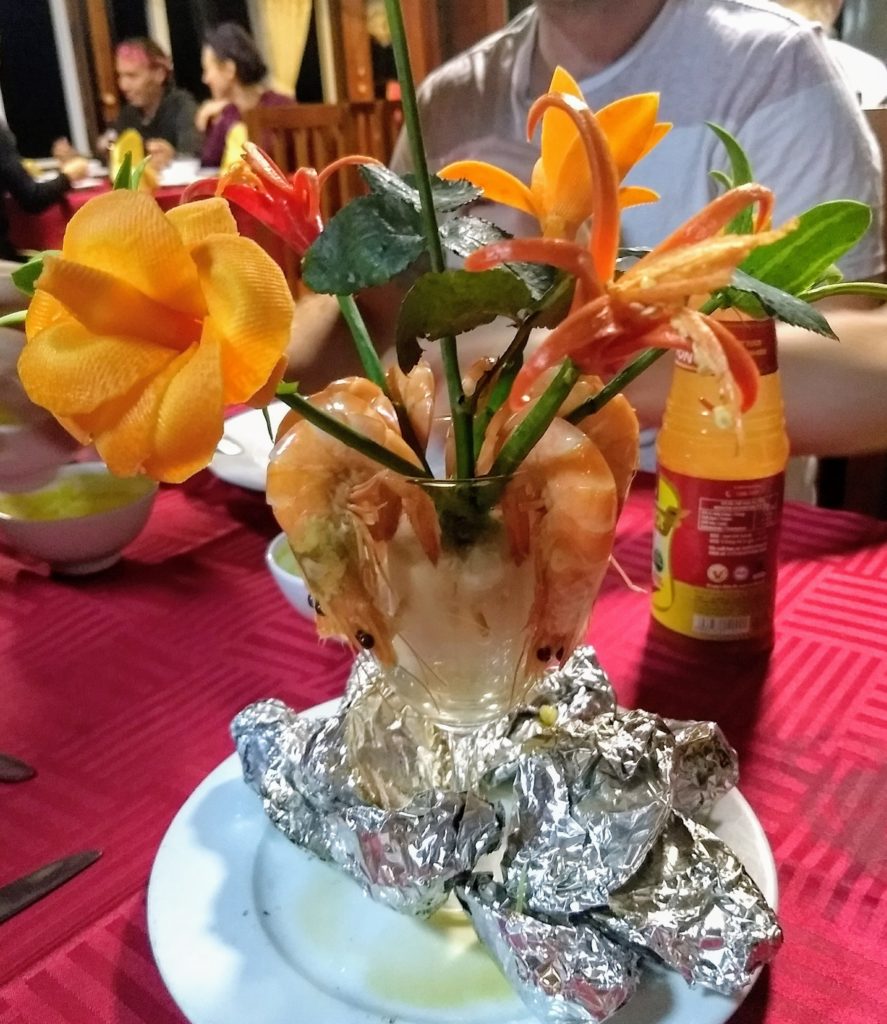
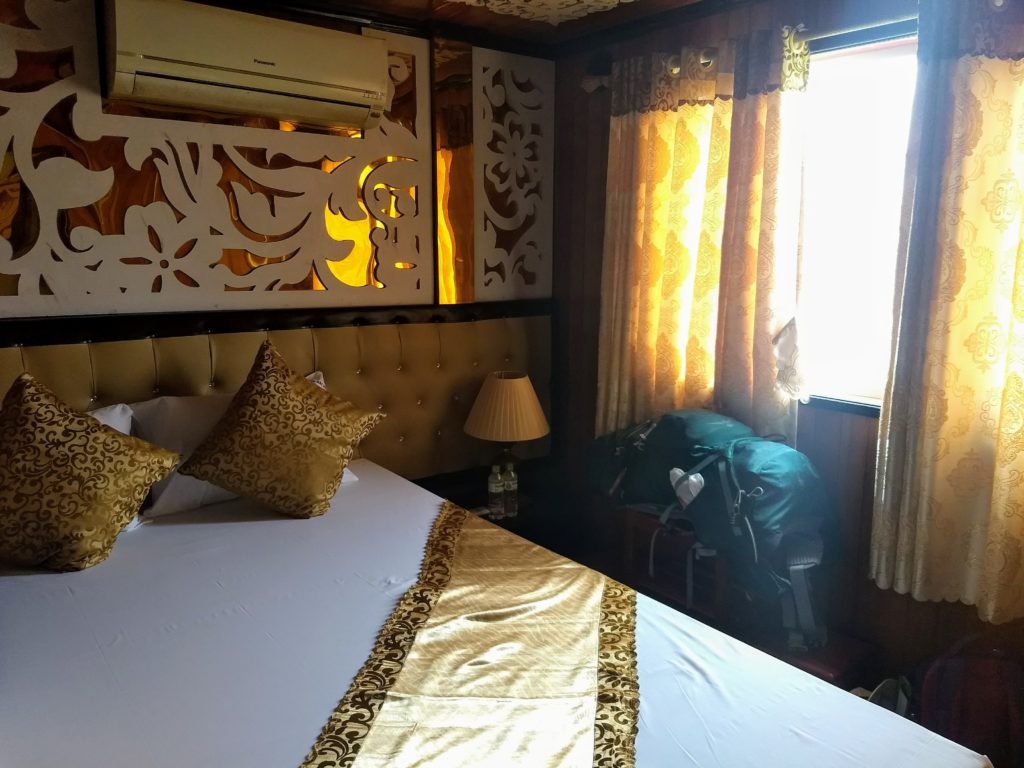 Photo, left: The Vietnamese are really into fruit carving! Photo, right: My room for the night
Photo, left: The Vietnamese are really into fruit carving! Photo, right: My room for the night
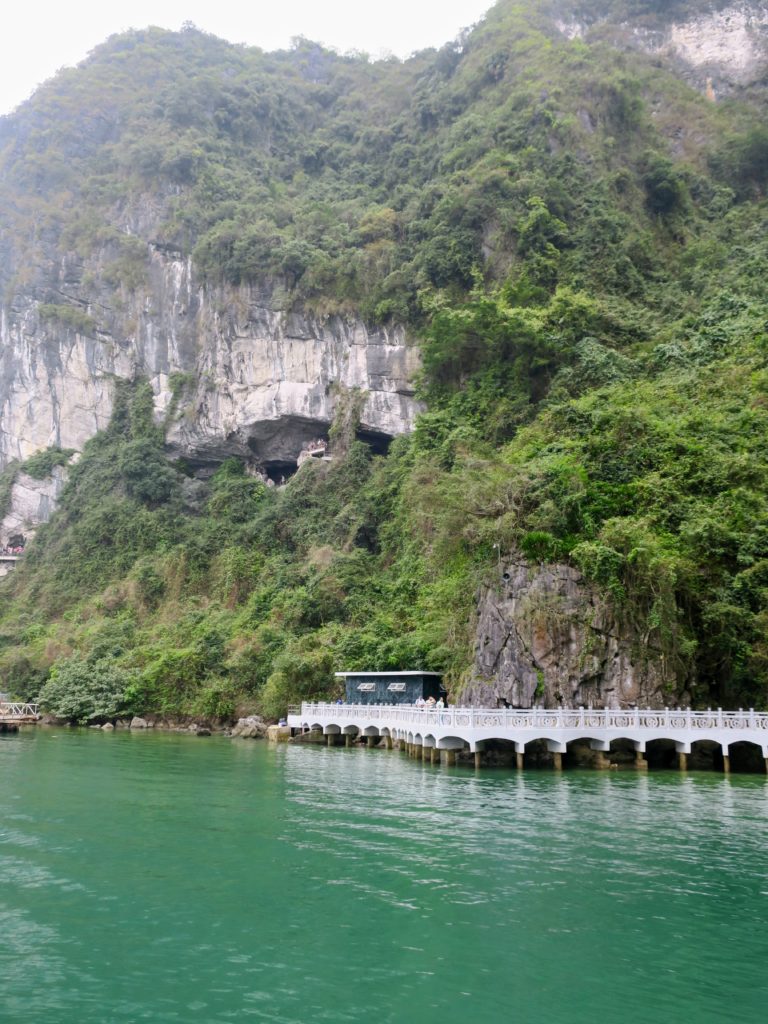
We had been told by our guide that the cave we were visiting the next morning was the busiest one and therefore he suggested we leave at 7am in order to be the first the explore it. That meant we were having breakfast at 6h30am! Did I mention I had been looking forward to this relaxing cruise? Somewhat doubtful (wouldn’t all the ships be doing the same thing?), we did as we were told. Lo and behold, he was right! We were the first (and only) group in the cave!
Although the entrance is only accessible after a steep climb, the hard work early in the morning is worth it!
Sung Sot Cave lived up to its other name: Amazing Cave. Featuring 3 grottos, each more spacious than the previous, it also served as a home to ancient people of the area.
The rocky formations inside inspiring images of varying animal and human forms, while colourful lights add flavour to the atmosphere.
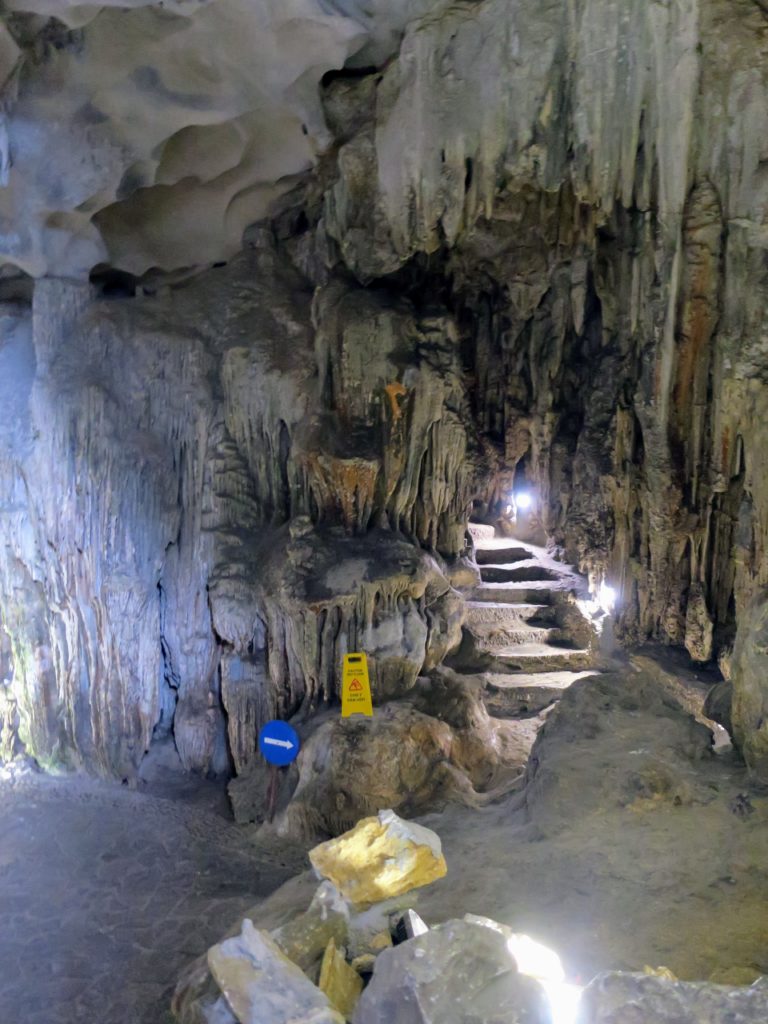
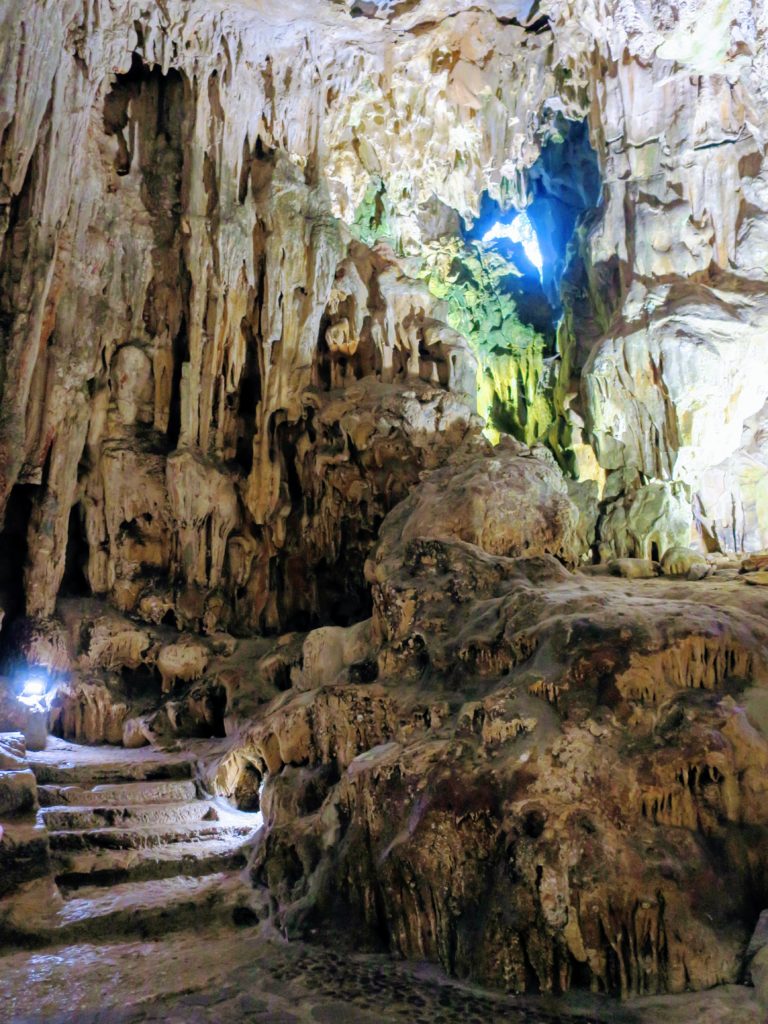 Note the yellow ‘caution’ sign… a rare Vietnamese display of safety concern!
Note the yellow ‘caution’ sign… a rare Vietnamese display of safety concern!
 Now, remember when I mentioned I don’t always read the fine print and that again, I was looking forward to a relaxing cruise? Well, was I in for a surprise. I had apparently signed up for an action-packed, activity filled cruise that included the entire day spent hiking, climbing, kayaking & cycling! After our caving, we were boated to another island, Ti Top were we ascended (and then descended) 400+ steps to reach the top. Granted, the view was unspeakably amazing (see ‘calendar photo’ at the beginning of this post), but the steep climb was quite the workout! Luckily, Ti Top Island has a beautiful white sand beach where we were able to relax for the following hour. Check out this 360 degree photo taken by a professional Italian photographer, who was on my tour (click here)
Now, remember when I mentioned I don’t always read the fine print and that again, I was looking forward to a relaxing cruise? Well, was I in for a surprise. I had apparently signed up for an action-packed, activity filled cruise that included the entire day spent hiking, climbing, kayaking & cycling! After our caving, we were boated to another island, Ti Top were we ascended (and then descended) 400+ steps to reach the top. Granted, the view was unspeakably amazing (see ‘calendar photo’ at the beginning of this post), but the steep climb was quite the workout! Luckily, Ti Top Island has a beautiful white sand beach where we were able to relax for the following hour. Check out this 360 degree photo taken by a professional Italian photographer, who was on my tour (click here)
After lunch on the boat, half of the group boarded a smaller craft to head towards our next destination: Cat Ba Island.
 The entrance to Cat Ba National Park included a steep, 10% incline that no one from the group was able to successfully bike up. Despite our best attempts, wee all had to resort to walking our bike up the hill!
The entrance to Cat Ba National Park included a steep, 10% incline that no one from the group was able to successfully bike up. Despite our best attempts, wee all had to resort to walking our bike up the hill!
We cycled 15 km to a remote farming Village where we then undertook what our guide called a ‘difficult’ hike in the Cat Ba National Park. Now, I use the term ‘hike’ loosely here: it can best be described as climbing or bouldering or attempting to defy death as we came to refer to it. What started out as a blissful walk through the forest soon transformed into an all out rock climb, minus ropes, harnesses or any other safety precautions. A couple from our group had realized they had forgotten their phone in the basket of their bike, so they went back early on to retrieve it; when they hadn’t returned in the expected time, our guide left us to tackle the climb on our own and went in search of them. Well, somehow I found myself in the lead of the group (how did that happen?) and could hear everyone behind me echoing my thoughts: ‘I can’t believe we’re doing this’, ‘this is crazy’ and my personal favourite ‘where’s the sign warning us of the possibility of death’. At one point, we were assisted by a makeshift ladder, which was no more than wooden sticks wedged in-between holes in the rocks. It’s quite the feeling when you’re about 100ft off the ground, pulling on these sticks to haul your body up the cliffs, praying they don’t let go. At one point, we had to cross over an outcrop of rock, with the ledge just wide enough to allow one foot to be placed at a time, a sheer drop just below. This was the type of trail that you look at and think: ‘oh no, the trail has been blocked by a rock landslide, there’s nowhere to go now’ or even ‘ where did the trail disappear to?’ as you frantically look around, only to realize that in fact, the mess of jagged rocks in front of you IS the trail. Now, you might think I’m exaggerating a bit for dramatic effect: trust me, I really am not! All I could think was, ‘this would never be allowed in Canada!’. Once we reached the top, our guide finally caught up to us, gracefully making his way up the cliff in a manner that lead us to believe he was part goat.
Click here to check out another amazing 360 degree photo taken at the top of our hike. If you look closely, you can see the rocky trail below the group.
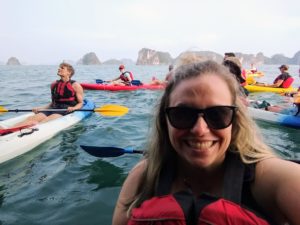 Our hike down was quicker yet no less treacherous and we all managed to escape any major injuries! Our group was definitely tighter after that death-defying experience, despite our guide’s claim that it ‘wasn’t that bad’. We biked another 15km to return to our boat and after a quick 30 minute break, we were back out on the water, ready for another few hours of sea kayaking. This time around, my tandem partner was the only other ‘single’ traveller in the group: a 40-year-old Bulgarian man from Montreal (Go Canada!). Well, I may not have a lot of experience sea kayaking, but I know for a fact that you aren’t supposed to bring the kayak to a complete stop every time you make a course correction! After 30 minutes of continually started from a full stop, I was exhausted! And bless him, he would also stop paddling for 5-10 minutes at a time in order to take photos, which meant that I was the only one paddling. Turns out, it was easier that way! Haha. Girl power for the win.
Our hike down was quicker yet no less treacherous and we all managed to escape any major injuries! Our group was definitely tighter after that death-defying experience, despite our guide’s claim that it ‘wasn’t that bad’. We biked another 15km to return to our boat and after a quick 30 minute break, we were back out on the water, ready for another few hours of sea kayaking. This time around, my tandem partner was the only other ‘single’ traveller in the group: a 40-year-old Bulgarian man from Montreal (Go Canada!). Well, I may not have a lot of experience sea kayaking, but I know for a fact that you aren’t supposed to bring the kayak to a complete stop every time you make a course correction! After 30 minutes of continually started from a full stop, I was exhausted! And bless him, he would also stop paddling for 5-10 minutes at a time in order to take photos, which meant that I was the only one paddling. Turns out, it was easier that way! Haha. Girl power for the win.
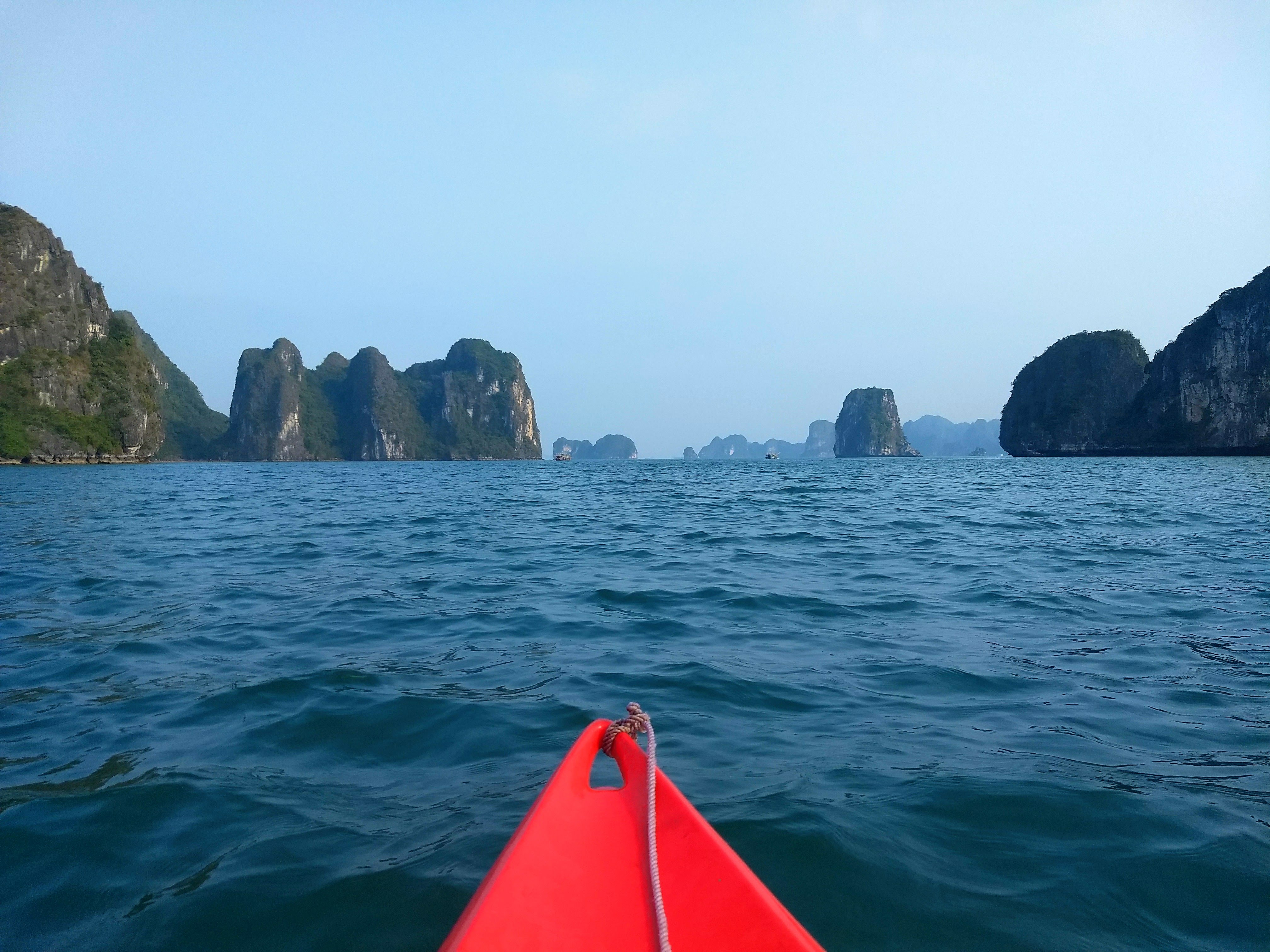 I could get use to this view
I could get use to this view
We ended the day on Cat Ba Island, settled comfortably into moderately swanky hotel rooms. A few of us went out on the town to enjoyed a nice meal and refreshing drinks before turning in for the night. The next day, we were promised that the only activity was sunning ourselves on the top deck as we meandered our way through the karst islets. On our way, we sailed by one of the bay’s most interesting sights: Cai Beo floating village. Composed of over 700 families, this is the country’s largest floating village. Most residents are fisherman and their families, with some choosing to farm mollusk from their floating houses.
 If you look closely, you can see satellites set up on some of the houses
If you look closely, you can see satellites set up on some of the houses People here farm over 450 different types of mollusks!
People here farm over 450 different types of mollusks! 
After 3 beautiful days spent on the water, exploring what Ha Long Bay has to offer, sweating it up doing some fun activities with some amazing people, I could safely say that this was, by far, one of the highlights of my time in Vietnam!

